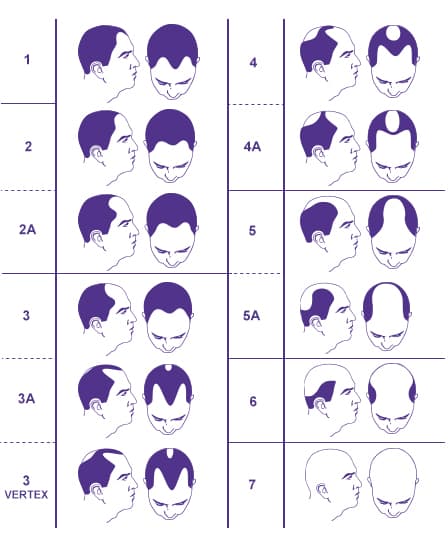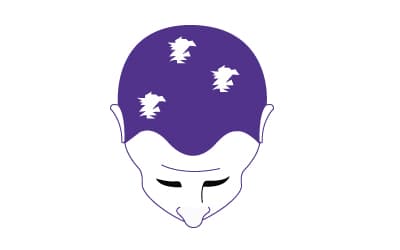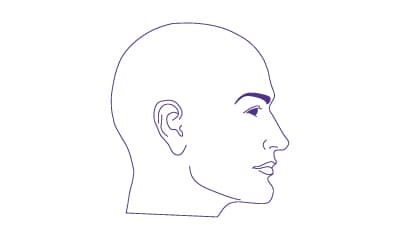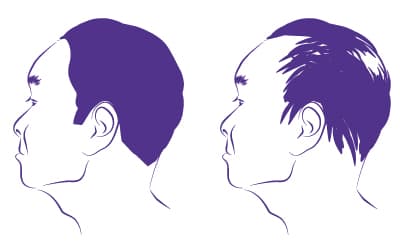- Private & confidential service
- Genuine medication
- All-inclusive service - No hidden fees
- Next day delivery
- Hair Loss
Hair Loss: start your consultation
- 1. Answer the online medical questions
- This helps our doctors to decide which treatment is safe for you
- 2. Select your treatment
- You will see a list of recommended treatments. You can select the one you prefer.
- 3. Checkout and delivery
- Once you’ve completed the checkout, our doctors will review your answers. If all is safe, you will receive your treatment tomorrow.

- Prevents further hair loss
- Can help regrow hair
- Generic version of Propecia
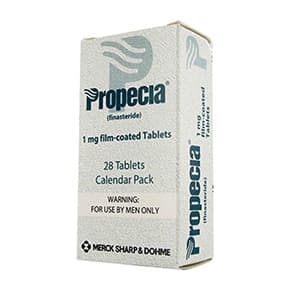
- Can halt further hair loss
- Can encourage hair regrowth
- Long-term effective tablets
Hair Loss
Alopecia (hair loss) affects approximately 60% of men with around 25% beginning to lose their hair before they reach the age of 30. The most common form of hair loss in men is male pattern baldness. For more information about the causes of male hair loss and how to treat it, you can read below.
We provide proven treatment for male pattern baldness that can be delivered straight to your home or work place with complete discretion. Complete a free consultation to get started.
Topics
What is male pattern baldness?
95% of male hair loss is caused by male-pattern-baldness (MPB), with over 50% of men over the age of 50 suffering from the condition. At a certain age, those with an inherited sensitivity to the hormone dihydrotestosterone (DHT) begin to lose their hair. DHT causes follicles to shrink, and with each growth cycle, the shaft of the hair also shrinks.

What are the different types of hair loss?
Alopecia can occur in different ways and can often be classified into different types, each with varying levels of occurrence. Some of these include:
The hereditary male pattern hair loss (androgenic alopecia) is often described as an inherited trait as it forms over 90% of male hair loss cases. Often the hair begins to thin out in the mid-twenties, which is often characterised by a receding hairline. This is also the most common case of female hair loss.

This type of hair loss is also referred to as hormonal-hereditary hair loss as it is caused by genetic hypersensitivity of the hair root cells to androgens, in particular the male hormone testosterone. When the enzyme 5-alpha reductase converts testosterone to at a higher than normal level, the DHT then attacks the hair follicles at the root, preventing any further growth of strong hair.
The second most common form is spot or patch baldness (alopecia areata). This is often an autoimmune diseases caused by the body attacking certain areas of the body with hair (usually the scalp) believing there to be a threat. This resulting attack usually causes inflammation in the set area causing the hair to fall out.

The patches may be of different sizes or shapes but are often round or oval. Alopecia areata (AA) can occur over a small period of time or on a longer term basis with a certain side of the scalp being affected compared to the other. Approximately 1-2% of all men are affected by alopecia areata.
- Another form of hair loss closely linked with alopecia areata is total hair loss (alopecia totalis). It is often known as complete hair loss loss of hair on the scalp and is also caused by an autoimmune disease similarly to alopecia areata. It is often seen as being in-between alopecia areata and alopecia universalis (total loss of hair across the whole body).

It is often difficult to assess the main cause or trigger for this type of hair loss, but it is said to affect mainly young people, those under the age of 40 and those who have just completed chemotherapy. There is a small chance that hair regrowth can occur if the condition is treated, but this is not often.
Traction hair loss (traction alopecia) is mainly prevalent in women and occurs mainly due to hair styling procedures. Excessive pulling, heating, bleaching, dyeing braiding and binding can put too much strain on the scalp and hair follicles. These in effect can cause inflammation of the scalp and result in increased loss of hair in that area. Fortunately this can be remedied through the use of better hair products and adopting safer styling practices.

- When an individual goes through bouts of high stress or psychological issues, they might shed or lose more hair than normal for a short while, this is often known as temporary hair loss (alopecia effluvium). The loss of hair is usually more prominent at the top of the head and sometimes around the temple but there is rarely any chance of hair line recession. This condition is more evident in women who have just given birth or those with extremely poor diets. Alleviating such stressful situations can see the hair returning back to its previous level.

What are the causes of hair loss in men?
Causes range from genetics and medical conditions to lifestyle factors. However, the most common is 'androgenic alopecia', more typically referred to as 'male pattern baldness'. This is a hereditary condition where the body becomes particularly sensitive to the hormone dihydrotestosterone (DHT), which leads to thinning hair. Diet, stress and illness are less common causes. If you believe one of these to be the reason for your hair loss, you should seek medical advice immediately.

The significance of DHT and male hair loss
Associated with an overabundance of the testosterone-related male hormone DHT (dihydrotestosterone) that attacks hair follicles causing them to shrink, some of the best hair loss treatments operate by targeting this hormone's production - thus reducing its potency.

Hair loss and age
Often hair loss is just an inevitable part of the ageing process, so it's nothing to be concerned about. As you age, your hairline will almost always recede and 2 out of 3 men experience significant hair loss by the time they reach the age of 60. Whilst there are some contributing lifestyle factors, such as diet and stress, androgenic alopecia is largely genetic and an inevitable part of the male ageing process.
However, there are some men, approximately 1 in 5, who will experience very little hair loss even into their 80's.
Myths about male hair loss
Over the centuries, various myths surrounding the causes and effects of male pattern baldness have arisen. Below we take a look at some of them and dispel the falsehoods.
|
|
What is the hair loss treatment for men?
As of now, there is no permanent cure for baldness, but there are ways to slow and even reverse the process in some cases.

Herbal hair loss products
Out of all the available herbal hair loss treatments available online, the most popular is Saw Palmetto. Made famous by Native Americans, Serenoa palm is also used as an alternative medicine to treat prostate cancer.
Despite its popularity, clinical studies have shown it to be no more effective than a placebo for treating baldness or progressive hair loss.
Over the counter treatments
There are many natural remedies and creams available to buy over-the-counter that claim to help restore your hair. These range from creams to hair loss shampoos. However, of all these apparent hair loss cures, many of them have little clinical data to back up their claims.
Minoxidil lotion (sold as Regaine) is one exception. This is a topical lotion, which, if applied directly to the scalp twice daily, helps you to combat male pattern balding. Some men find that Regaine can be useful for both slowing hair loss and regrowing hair, but needs to be applied straight to the scalp, which can often be inconvenient.
Regrowth will normally take a few months and the results are usually noticed around the crown of the scalp. Regaine is for genetic hair loss only; it is not effective for hair loss due to other causes.
Hair transplant surgery
There are three main surgical treatments, which can be used to treat hair loss. A transplant involves taking hair from the back of your head, and moving it to the front of the scalp. Another treatment is scalp reduction, which can reduce a mild bald patch by removing a piece of your scalp and stretching the area where hair is thicker over it. Flap surgery involves stretching healthy scalp over a small area of hair loss.
Besides being expensive and invasive, each of these treatments may need to be repeated at a later date. If you're unsure about whether this kind of treatment is suitable for you, it's always recommended to speak to a medical professional or to call a reputable hair loss clinic.
Wigs
If you're experiencing hair loss as a result from cancer and chemotherapy, wigs are an excellent choice, and are available on the National Health Service if you meet certain criteria. Even if you don't, there are various support options available to help with the cost of your wig.
If you're in this situation, the NHS has some important information that can offer advice about wigs and hairpieces.
Prescription hair loss medicines
Whilst there are many over-the-counter remedies for assistance in preventing male pattern baldness, the only one to be clinically proven to be effective is Propecia.
Propecia is the first and only proven medication to treat male pattern hair loss on the vertex (top of head) and anterior mid-scalp area (middle front of the head). Propecia uses the active ingredient Finasteride to inhibit the activity of DHT, the primary cause of male pattern hair loss. 90% of men who took Finasteride either maintained scalp coverage or showed visible improvement over 5 years.
Propecia is an easy once a day medication, which causes very few side effects.
How can hair loss be prevented with lifestyle changes?
Preventing hair loss can be difficult, and will largely depend on your type of hair loss. Male pattern baldness (androgenic alopecia) is usually caused by hereditary factors, and therefore it's difficult to physically prevent, at least without prescription treatment.
The following lifestyle tips may not be guaranteed to prevent hair loss, but can improve the quality of your hair follicles and hair itself:
Follow a balanced diet - Hair follicles are made up of proteins and because of this, specialists recommend that you fit plenty of protein in to your diet. Beans are also a major source of protein, as are fish, soya, dairy, cheese and nuts.
Avoid certain shampoos - Some hair care products contain chemicals that can be harmful to your hair. For this reason, it's often best to choose organic shampoos that don't contain any chemicals.
Increase the calcium in your diet - Calcium has also been hailed as a valuable vitamin for hair loss, and has also been shown to be beneficial for hair strength, thickness, and overall health.
What prescription hair loss treatments are available?
Minoxidil (Regaine/Rogaine) and Finasteride (Propecia) are two clinically tested medications considered the best choices for combatting hair loss. Minoxidil is available over the counter and can be applied as a foam, directly to the scalp. Finasteride requires a prescription and is available in 1mg tablet form, to be taken daily.
Infographic about hair loss

medical form
medication
prescription
from pharmacy


